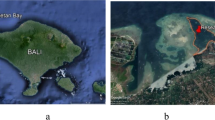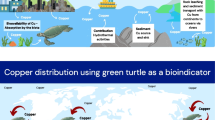Abstract
Sediment and American oyster (Crassostrea virginica) collected from nine selected marsh/estuarine ecosystems in Savannah, Georgia were analyzed for elements such as Al, As, B, Cd, Cr, Cu, Fe, Hg, Mn, Mo, Ni, Pb, Si, and Zn. Sediments were extracted by ammonium acetate (NH4OAc), Mehlich-3 (M-3), and water procedures, whereas an acid digestion procedure was adopted for oyster tissue. Concentrations of elements were higher in M-3 extractions followed by NH4OAc and water extraction procedures. Calcium and Mg was greater in sediments by any of the extractions, whereas other elements differed depending upon the extraction procedures. There were no significant spatial variations (p < 0.05) of any of elements analyzed except Mn, in NH4OAc/water extraction procedure and Fe and Al by water extraction procedure. Contamination of Al, B, Cd, Cr, Cu, Fe, Mn, Mo, Ni, Pb, Si, and Zn in oyster tissue ranged from 399 to 1460, 231 to 254, <1.5 to 2.9, <1.5 to 8.0, 67 to 121, 232 to 1357, 17 to 54, <0.5 to 0.64, <1.5 to 2.5, <1.5 to 4.0, 241 to 381, and 978 to 2428 μg/g dry weight (dw), respectively. Greatly elevated concentrations of elements such as P, Ca, Mg, K, and S were noticed in oyster tissue. The concentration range of Hg and As in sediment was 1.2–1.9 and 11–55 μg/g dw, respectively. The concentration range of Hg and As in oyster tissue was 130–908 and 200–912 ng/g dw, respectively. With the exception of As and Hg, other elements are several orders of magnitude greater in oyster tissue. There is no significant (p < 0.05) contamination variation in target analyses between the nine selected sites. Concentrations of heavy metals in sediment and oyster were either comparable or lower than those of other countries. Greater biota-sediment accumulation factor was noticed for P and Zn. Concentrations of Hg and P in oyster tissue were higher than the threshold limit for human consumption. Overall, the baseline data can be used for regular ecological monitoring, considering the domestic and industrial growth around this important marsh/estuarine ecosystem.





Similar content being viewed by others
References
Ackermann F, Bergmann H, Schliechert U (1983) Monitoring of heavy metals in coastal and estuarine sediments-a question of grain size: <20 μm versus <60 μm. Environ Sci Technol Lett 4:317–328
Adriano DC (2001) Trace elements in terrestrial environments: Biogeochemistry, bioavailability, and risk of metals, second edition. Springer-Verlag, New York
Akagi H, Nishimura H (1991) Speciation of mercury in the environment. In: Suzuki T, Imura N, Clarkson TW (eds) Speciation of mercury in the environment. Plenum Press, New York, pp 53–76
Alquezar R, Markich SJ, Booth DJ (2006) Metal accumulation in the smooth toadfish, Tetractenos glaber, in estuaries around Sydney, Australia. Environ Pollut 142:123–131
Amaraneni SR (2006) Distribution of pesticides, PAHs and heavy metals in prawn ponds near Kolleru lake wetland, India. Env Int 32:294–302
Apeti DA, Johnson E, Robinson L (2005a) A model for bioaccumulation of metals in Crassostrea virginica from Apalachicola Bay, Florida. Am J Environ Sci 1:239–248
Apeti DA, Robinson L, Johnson E (2005b) Relationship between heavy metal concentrations in the American oyster (Crassostrea virginica) and metal levels in the water column and sediment in Apalachicola Bay, Florida. Am J Environ Sci 1:179–186
Ashraf MP, Edwin L, Meenakumari B (2006) Studies on the seasonal changes of phosphorus in the marine environment off Cochin. Env Int 32:159–164
Baptista NJA, Smith BJ, McAlister JJ (2000) Heavy metal concentrations in surface sediments in a nearshore environment, Jurujuba Sound, SE Brazil. Environ Pollut 109:1–9
Bloxham M, Rowe A, McGovern E, Smyth M, Nixon E (1998) Trace metal and chlorinated hydrocarbon concentrations in shellfish and finfish from Irish waters—1996. Marine environmental series 2/98, fishery leaflet 179, Marine Institute: 1–18
Burton M (2002) Copper and mercury in an oyster reef system, Ten Thousand Islands, Southwest Florida. http://www.216.109.125.130/search/cache?ei=UTF-8&fr=slv8-yie7&p=BURTON+MARGO++Geology+Dept&u=keck.wooster.edu/archives/symposium/02/Florida01_pdfs/burtonabs.pdf&w=burton+margo+geology+dept&d=fRUmFBIeOSGi&icp=1&.intl=us
Cauwet G (1987) Influence of sedimentological features on the distribution of trace metals in marine sediments. Marine Chemistry 22:221–234
Chindah AC, Braide AS, Sibeudu OC (2004) Distribution of hydrocarbons and heavy metals in sediment and crustacean (Shrimps-Penaeus notialis) from the Bonny/New Calabar River Estuary, Niger Delta. AJEAM-RAGEE 9:1–17
Crapez M, Neto JAB, Bispo MGS (2003) Bacterial enzymatic activity and bioavailability of heavy metals in sediments from Boa Viagem Beach (Guanabara Bay). Anuario Inst Geociencias UFRJ 26:60–68
Day JW, Hall CAS, Kemp WM, Alejandro YA (1989) Estuarine ecology. John Wiley & Sons, New York, 558 p
Deely JM, Tunnicliff JC, Orange CJ, Edgerley WHL (1992) Heavy metals in surface sediments of Waiwhetu Stream, Lower Hutt, New Zealand. N Z J Marine Freshwater Res 26:417–427
De Groot AJ, Salmons W, Allersma E (1976) Processes affecting heavy metals in estuarine sediments. In: Burton JD, Liss PS (eds). Estuarine chemistry. Academic Press, London, pp 131–157
DRI (1997) http://www.en.wikipedia.org/wiki/Dietary_Reference_Intake
Elston R, Cake EW Jr, Humphrey K, Isphording WC, Rensel JE (2005) Dioxin and heavy-metal contamination of shellfish and sediments in St. Louis Bay, Mississippi and adjacent marine waters. J Shellfish Res 24:227–241
Forstner U (1989) Contaminated sediments: Lectures on environmental aspects of particle-associated chemicals in aquatic systems. Springer-Verlag, Berlin, Heidelberg, New York, 157 p
Forstner U, Wittmann GTW (1981) Metal pollution in the aquatic environment. 2nd edition. Springer-Verlag, Berlin, Heidelberg, New York, p 486
Frazier JM (1975) The dynamics of metals in the American oyster, Crassostrea virginica. I. Seasonal effects. Chesapeake Sci 16:162–171
Frias-Espericueta MG, Ortiz-Arellano MA, Osuna-Lopez JI, Ronson-Paulin YJA (1999) Heavy metals in the rock oyster Crassostrea iridescens (Filibranchia: Ostreidae) from Mazatlan, Sinaloa, Mexico. Rev Biol Trop 47:843–849
Goldberg ED, Koide M, Holdge V, Flegal AR, Martin J (1983) U.S. mussel watch: 1977–1978 results on trace metals and radionuclides. Estuarine Coastal Shellfish Sci 16:69–93
Haye JM, Santschi PH, Roberts KA, Ray S (2006) Protective role of alginic acid against metal uptake by American oyster (Crassostrea virginica). Environ Chem 3:172–183
Honda K, Tatsukawa R, Fujiyama T (1982) Distribution characteristics of heavy metals in the organs and tissues of striped dolphin, Stenella coeruleoalba. Agric Biol Chem 46:3011–3021
Horowitz AJ (1985) A primer on trace element-sediment chemistry. US Geological Survey Water Supply Paper 2277, 67 p
Ichihashi H, Nakamura Y, Kannan K, Tsumura A, Yamasaki S (2001) Multi-elemental concentrations in tissues of Japanese common squid (Todarodes pacificus). Arch Environ Contam Toxicol 41:483–490
Ikemoto T, Kunito T, Watanbe I, Yasunaga G, Baba N, Miyazaki N, Petrov EA, Tanabe S (2004) Comparison of trace element accumulation in Baikal seals (Pusa sibirica), Caspian seals (Pusa caspica) and northern fur seals (Callorhinus ursinus). Environ Pollut 127:83–97
Jayaprakash M, Srinivasalu S, Jonathan MP, Ram Mohan V (2005) A baseline study of physico-chemical parameters and trace metals in waters of Ennore Creek, Chennai, India. Mar Pollut Bull 50:583–608
Kannan K (1999) Clam-sediment accumulation factors for polychlorinated biphenyl congeners at a contaminated estuarine marsh. Toxicol Environ Chem 68:159–167
Kannan K, Sinha RK, Tanabe S, Ichihashi H, Tatsukawa R (1993) Heavy metals and organochlorine residues in Ganges River dolphins from India. Mar Pollut Bull 26:159–162
Kannan K, Smith RG Jr, Lee RF, Windom HL, Heitmuller PT, Macauley JM, Summers JK (1998) Distribution of total mercury and methyl mercury in water, sediment, and fish from south Florida estuaries. Arch Environ Contam Toxicol 34:109–118
Kannan K, Yasunaga Y, Iwata H, Ichihashi H, Tanabe S, Tatsukawa R (1995) Concentrations of heavy metals, organochlorines, and organotins in horseshoe crab, Tachypleus tridentatus, from Japanese coastal waters. Arch Environ Contam Toxicol 28:40–47
Karadede H, Oymak SA, Unlu E (2004) Heavy metals in mullet, Liza abu, and catfish, Silurus triostegus, from the Ataturk Dam Lake (Euphrates), Turkey. Env Int 30:183–188
Kongchum M, Devai I, DeLaune RD, Jugsujinda A (2006) Total mercury and methylmercury in freshwater and salt marsh soils of the Mississippi river deltaic plain. Chemosphere 63:1300–1303
Kuppusamy MR, Giridhar VV (2006) Factor analysis of water quality characteristics including trace metal speciation in the coastal environmental system of Chennai Ennore. Env Int 32:174–179
Machado FAG, Zalmon IR (2005) Temporal and spatial variation on heavy metal concentrations in the oyster Ostrea equestris on the Northern Coast of Rio De Janeiro State, Brazil. Brazil J Biol 65:67–76
Magalhaes CC, Krug FJ, Fostier AH, Berndt H (1997) Dietary determination of mercury in sediments by atomic adsorption spectrometry. J Anal Atomic Spectrometry 12:1231–1234
Mathew M, Mohanraj R, Azeez PA, Pattabhi S (2003) Speciation of heavy metals in bed sediments of wetlands in Urban Coimbatore, India. Bull Environ Contam Toxicol 70:800–808
McLean GW (1982) Hydrogen-ion activity. In: Page AL et al. (ed.) Methods of soil analysis. Part II, 2nd ed. Agronomy 9:159–164
Mehlich A (1984) Mehlich 3 soil test extractant: A modification of Mehlich 2 extractant. Comm Soil Sci Plant Ana 15:1409–1416
Moss A, Constanza S (1998) Levels of heavy metals in the sediments of Queensland rivers, estuaries and coastal waters. Environmental technical report no. 20- ISSN 1037-4671, Queensland Government, Australia
Peakall D, Burger J (2003) Methodologies for assessing exposure to metals: speciation, bioavailability of metals and ecological host factors. Ecotoxicol Environ Safety 56:110–121
Phelps HL, Mihursky JA (1986) Oyster (Crassostrea virginica, Gmelin) spat settlement and copper in aufwuchs. Estuaries 9:127–132
Rodrigo AG (1989) Surfacial sediment-heavy metal associations in the Avon-Heathcote Estuary, New Zealand. N Z J Marine Freshwater Res 23:255–262
Sajwan KS, Senthil Kumar K, Suresh N, Fowler A, Richardson JP, Loganathan BG (2007) Persistent -organochlorine pesticides, -polychlorinated biphenyls and -polybrominated diphenyl ethers in fish from coastal waters off Savannah, Georgia, USA. Toxicol Env Chem (DOI: 10.1080/02772240701270047)
Sakai H, Saeki K, Ichihashi H, Kamezaki N, Tanabe S, Tatsukawa R (2000) Growth-related changes in heavy metal accumulation in green turtle (Chelonia mydas) from Yaeyama Islands, Okinawa, Japan. Arch Environ Contam Toxicol 39:378–385
Sankar TV, Zynudheen AA, Anandan R, Viswanathan Nair PG (2006) Distribution of organochlorine pesticides and heavy metal residues in fish and shellfish from Calicut region, Kerela, India. Chemosphere 65:583–590
Senthil Kumar K, Sajwan KS, Richardson J (2007) A baseline monitoring of heavy metals, organochlorine pesticides, polycyclic aromatic hydrocarbons and alkylphenols in sediment and oyster collected from marsh/estuarine Savannah, GA. Mar Pollut Bull (in press)
Singh BR, Steinnes E (1994) Soil and water contamination by heavy metals. In: Lal R, Stewart BA (eds) Soil processes and water quality. Lewis, Boca Raton, Florida, pp 233–272
Smyth M, Rowe A, McGovern E, Nixon E (1995) Monitoring of shellfish growing areas—1995. Marine environmental series 1/97, fishery leaflet 174, Marine Institute, pp 1–11
Storelli MM, Storelli A, D’Addabbo R, Marano C, Bruno R, Marcotrigiano GO (2005) Trace elements in loggerhead turtles (Caretta caretta) from the eastern Mediterranean Sea. Overview and evaluation. Environ Pollut 135:163–170
Thomas GW (1982) Exchangeable cations: In: Page AL (ed) Methods of soil analysis, part 2, 2nd ed. Agronomy 9:159–164
USFDA (1993) Guidance document for arsenic, chromium, nickel in shellfish. Center for Food Safety and Applied Nutrition. United States Food and Drug Administration, Washington, DC
Acknowledgments
Part of this study was financially supported by the U.S. National Park Service, Department of Interior (grant/order number P5420050005). Part of this research was performed under the auspices of contract number DE-FG09-96SR18558, United States Department of Energy and Environmental Protection Agency. We wish to thank the management and staff of Bull River Marina for allowing us to use space at their marina for overnight boat docking and for allowing us to load and unload equipment and personnel during the field sampling period. We thank Captain Jay Rosenzweig, Savannah State University, for his cooperation and skill during boat sampling trips.
Author information
Authors and Affiliations
Corresponding author
Rights and permissions
About this article
Cite this article
Sajwan, K.S., Kumar, K.S., Paramasivam, S. et al. Elemental Status in Sediment and American Oyster Collected from Savannah Marsh/Estuarine Ecosystem: A Preliminary Assessment. Arch Environ Contam Toxicol 54, 245–258 (2008). https://doi.org/10.1007/s00244-007-9033-1
Published:
Issue Date:
DOI: https://doi.org/10.1007/s00244-007-9033-1




